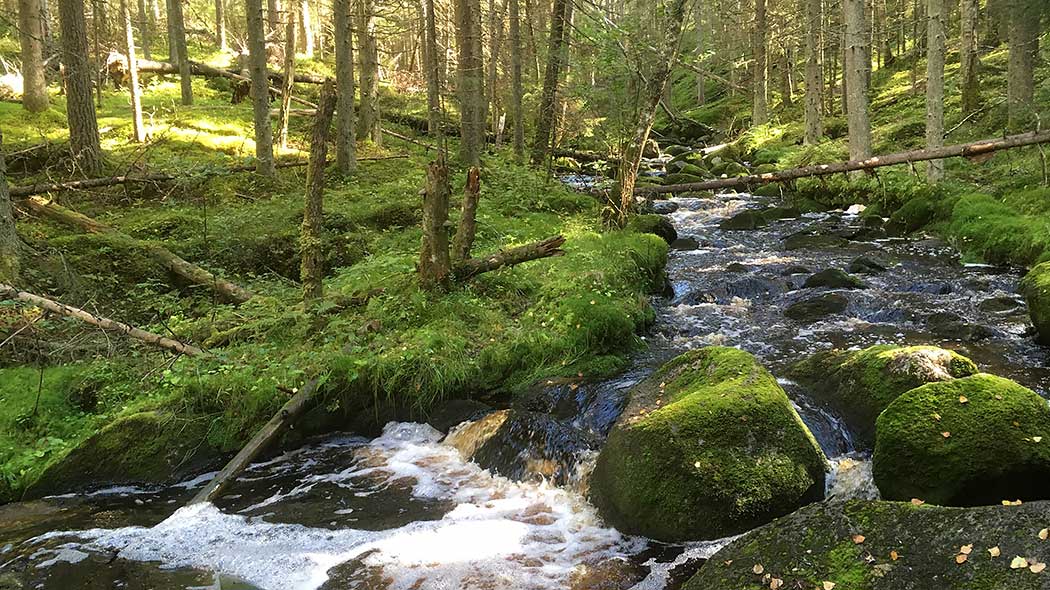Natural Features of Kauhaneva-Pohjankangas National Park

The extensive raised bog of Kauhaneva, Pohjankangas esker forests and Katikankanjoni ravine: the treasures of Kauhaneva-Pohjankangas National Park. Kauhaneva is an internationally significant mire. During spring time, the birds of the mire create a cacophony of sound but in the winter, there is nothing but silence in the mire.
Treasures of the Mire Environment

In South Ostrobothnia Region, Kauhaneva is the largest raised bog with hummocks. Together with Kampinkeidas Mire on its north-west side, it forms an internationally important mire complex.
Raised bogs are mires where turf has grown higher than the surrounding mineral soil. The centre is often a couple of metres higher than the edges. Raised bogs are low in nutrients, and therefore the centre parts are barren of vegetation, since they only receive nutrients with the rainwater.
Raised bogs consist of drier hummocks and between them deceitfully soft and wet hollows, or puddles with open water. On the dry hummocks grow Sphagnum moss (Sphagnum sp), and sparse tortuous pines (Pinus sylvestris). Large puddles between the hummocks are a good habitat for mire birds. On Kauhaneva, there are hundreds of puddles with clear open water.
Kauhaneva Mire has three centres, where around a puddle there are circular formations of hummocks. Outside these centres is a soggy fen, which in the south turns into huge open aapa-like mire. The open aapa-like mires have more nutrients, as they get addition from the surrounding mineral soils during the spring floods.
Springs Bring Oxygen to the Fens
Kauhaneva also has spring fens which the area’s groundwater springs supply with clear, cold water. The water remains at an even temperature round the year, and thanks to the flow, it is rich in oxygen. The spring fens offer habitat for a unique selection of species. The nutrient-rich, fresh waters of the spring fens are home to such plants as the greater tussock-sedge (Carex paniculata), the fibrous tussock-sedge (Carex appropinquata) and Herzogiella turfacea mosse. Spring fens are relatively rare in Southern Finland.
The Wood sandpiper and the Park's Other Birds
On Kauhaneva Mire you can see for example Common Crane (Grus grus) and Whooper Swan (Cygnus cygnus), which bring up their young near the puddles. Walking on the mire, you can also observe the life of Herring Gulls (Larus argentatus), Little Gulls (Larus minutus), Yellow Wagtails (Motacilla flava) and European Golden Plovers (Pluvialis apricaria). Other bird species of the National Park include Whimbrel (Numenius phaeopus), Wood Sandpiper (Tringa glareola), Common Redshank (Tringa totanus) and Common Greenshank (Tringa nebularia). Also Black-throated Diver (Gavia arctica) and Red-throated Diver (Gavia stellata) have their home there.
Mating calls of Wetland Birds

The wood sandpiper (Tringa glareola) is the most common wader species in the mires of Kauhaneva. This species has declined slightly in recent years, and it has been declared one of the regionally endangered species in southern Finland. During late spring and early summer, you can hear its rhythmical mating call in the open mires of the National Park. The bird makes its nest in a sedge tussock. While the mates take turns sitting on the eggs, the male is left to look after the chicks as the female already migrates south in June.
Easy Walking on the Esker

Pohjankangas is part of the esker formation of Western Finland, which starts at Hämeenkangas running west, and continues as Pohjankangas running north up to the boundary of the South Ostrobothnia region. The forests are dry and barren heaths growing pine. The ground layer is dominated by reindeer lichen (Cladonia rangiferina) and Big Red Stem Moss (Pleurozium schreberi). Other indicator plants of Pohjankangas include the Heather (Calluna vulgaris), the Lingonberry (Vaccinium vitis-idaea) and the Bearberry (Arctostaphylos uva-ursi) .
On the barren and light pine heath lives also the European Nightjar (Caprimulgus europeaus). Its hypnotic churring can be heard in the light summer night, but the bird itself is not often seen, due to its excellent protective colouring. The morning song of the Common Redstart (Phoenicurus phoenicurus) can, in the summer, begin already at midnight.
Fairy-tale forest of Katikankanjoni and Kolmentuulenlakki Esker

Katikankanjoni ravine along the western side of the park was created in the last 9,000 years. The waters discharging from Kauhaneva mire and Kauhajärvi Lake have gouged a dense network of rivulets in the sandy soil. The steep slopes of the streams and the verdant spruce forests around them set the mood for this fairy-tale forest. The meandering stream at the bottom of the ravine continues to shape the landscape even today.
Kolmentuulenlakki is a triangular sand ridge with steep sides rising 15 metres above the stream valleys around it. It was created as the streams eroded the soil around it. The level area at the top was a popular place for Midsummer night’s and other celebrations in the past.
Returning the Mires back to their Natural State

On Kauhaneva Mire, the edged were drained during the 1960s and 70s. Today, the mires are being restored back to their natural state (metsa.fi). This means that the ditches which were dug earlier, are blocked, and the trees, which have grown because of draining, are felled. The aim is to get the water to rise back to the original level, and to reduce the evaporation by the trees, so that the original mire vegetation, which has partly disappeared, could grow back.
Internationally Recognised
Unique Geology, Diverse Mires, Valuable Wetlands

Kauhaneva-Pohjankangas National Park is a Ramsar site, or an internationally significant wetland area. The Ramsar Convention protects wetlands, which are some of the most endangered habitats in the world. In addition to Kauhaneva-Pohjankangas, there are 49 other Ramsar sites in Finland.
The significant geological formations and diverse mires of the area are an important criterion when the park seeks recognition as part of UNESCO’s international Geopark network.
Kauhaneva-Pohjankangas National Park
- Established 1982
- Area 68 km²

The Emblem of Kauhaneva-Pohjankangas National Park is Wood Sandpiper.
Publications of Kauhaneva-Pohjankangas National Park
Publications of Kauhaneva-Pohjankangas National Park (julkaisut.metsa.fi)






